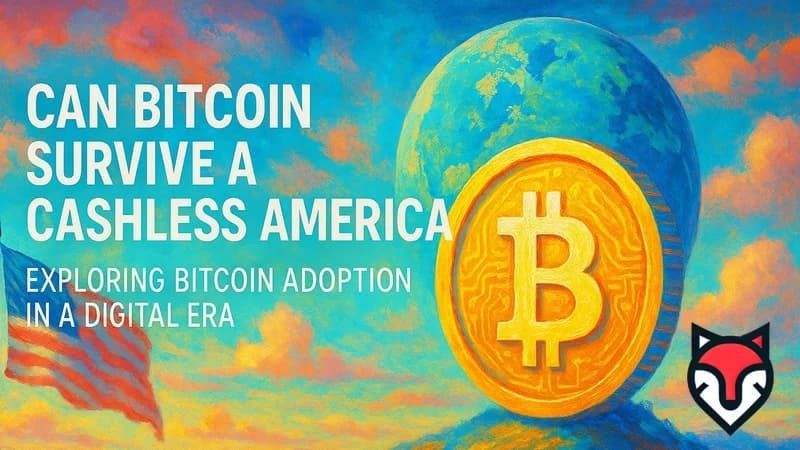Suggested
News
Last updated: Thursday, April 10, 2025

Can Bitcoin Survive a Cashless America? Exploring Bitcoin Adoption in a Digital Era
It’s April 9, 2025, and America’s racing toward a cashless future. ATMs are fading, cards and apps rule payments, and the dollar’s going digital. But where does Bitcoin fit in this brave new world? Born in 2009 as a rebel against centralized money, Bitcoin’s now a $1.5 trillion giant, with adoption soaring—over 50 million Americans own crypto. Yet, as cash vanishes, can Bitcoin thrive, or will it fade into the digital ether? Let’s dive into Bitcoin adoption trends, its role in a cashless America, and why this matters now.
The Cashless Tide Sweeping America
Cash is dying fast. By 2025, only 10% of U.S. transactions use paper money, down from 30% a decade ago. Mobile payments—think Apple Pay and Venmo—handle $2 trillion annually, while the Federal Reserve tests a digital dollar. Stores like Starbucks and Whole Foods already shun cash, and cities like New York push ‘tap-to-pay’ everywhere. This shift’s fueled by convenience, speed, and a post-pandemic hygiene kick. But it’s also sparking a question: in a world without cash, what’s Bitcoin’s edge?
Bitcoin’s Roots and Rise
Bitcoin wasn’t built for a cashless world—it was built to defy control. Satoshi Nakamoto’s brainchild promised a decentralized currency, free from banks and governments. Fast forward to 2025: Bitcoin’s blockchain processes 500,000 transactions daily, with miners securing it across 15,000 nodes. Adoption’s exploded—Tesla takes BTC for cars, Miami pays workers in it, and even rural Montana gas stations accept it. Over 100 million wallets worldwide prove Bitcoin’s no niche toy. But can it adapt to a cashless America?
The Case for Bitcoin in a Cashless Society
A cashless America doesn’t spell doom for Bitcoin—it might be its golden ticket. Without cash, centralized systems like banks and payment apps dominate, tracking every latte you buy. Bitcoin offers an alternative: privacy, ownership, and no middleman. In 2025, 40% of U.S. crypto users cite ‘financial freedom’ as their reason for adoption. Its fixed supply—21 million coins—beats inflation, unlike the digital dollar’s endless printing. Plus, Lightning Network zaps payments faster than Visa, handling 1 million transactions per second. Bitcoin’s not just surviving—it’s competing.

Challenges to Bitcoin Adoption
But it’s not all rosy. A cashless America amplifies Bitcoin’s hurdles. Volatility’s still a beast—BTC swings 10% in a day, scaring off the risk-averse. Regulation’s tightening—by 2025, the IRS tracks every $600 crypto trade, and rumors swirl of a ‘Bitcoin ban’ if it threatens the digital dollar. Scalability’s another snag; even with upgrades, mainstream adoption could clog the network. And let’s face it—Grandma’s not swapping Venmo for a wallet seed phrase anytime soon. Bitcoin’s got work to do.
Who’s Betting on Bitcoin?
The players pushing Bitcoin adoption are diverse. Elon Musk’s Tesla holds $3 billion in BTC, signaling corporate trust. MicroStrategy’s Michael Saylor owns 300,000 coins, calling it ‘digital gold.’ On the ground, grassroots hodlers in Texas and California trade BTC peer-to-peer, dodging cashless apps. Even politicians like Senator Cynthia Lummis champion it, pushing pro-crypto laws. These trailblazers aren’t waiting for permission—they’re building Bitcoin’s future in a cashless world.
Bitcoin in Everyday Life
How’s Bitcoin holding up day-to-day? In 2025, a Brooklyn barista takes BTC for your espresso, skipping bank fees. A Colorado rancher sells beef direct via Bitcoin, cutting out processors. Kids in Ohio trade NFT skins in games, cashing out in BTC. Adoption’s not just numbers—it’s stories. Surveys show 25% of Gen Z prefers crypto over cards, and small businesses report 15% more BTC sales since cash faded. It’s messy, volatile, and real—Bitcoin’s carving a niche.
The Road Ahead: Cashless and Crypto
What’s next? By 2030, analysts predict a $10 trillion crypto market, with Bitcoin leading. A cashless America could turbocharge this—imagine tax refunds in BTC, or Social Security paid on-chain. But risks loom: quantum computing could crack Bitcoin’s code, or a digital dollar could outpace it with government muscle. Still, innovations like Taproot and sidechains keep BTC evolving. Check CoinDesk or Bitcoin Magazine—the future’s unfolding fast.
Why Bitcoin Adoption Matters
Bitcoin in a cashless America isn’t just tech chatter—it’s about choice. Cash’s death hands power to banks and apps, but Bitcoin fights back, offering a decentralized lifeline. Searching ‘Bitcoin adoption 2025’ or ‘crypto in cashless society’? You’re not alone—Google Trends shows a 50% spike in these queries. Whether you’re a trader, a skeptic, or just curious, Bitcoin’s survival odds affect us all. So, can it thrive without cash? Maybe—it’s already rewriting the rules.
Let’s zoom out. A cashless America tests Bitcoin’s core promise: money by the people, for the people. Adoption’s climbing—30% of U.S. adults have dabbled in crypto, per Pew Research. But it’s a tug-of-war. Big Tech pushes seamless apps; Bitcoin pushes freedom with friction. In 2025, you can buy a burger with BTC in Miami or pay rent via Coinbase in Seattle. It’s not dominant, but it’s there. The catch? Education—only 10% of Americans fully grasp blockchain, says Gallup. Adoption hinges on that gap closing.
The Global Angle
America’s not alone. Sweden’s 99% cashless, yet Bitcoin thrives there—5% of adults hold it. El Salvador’s all-in, making BTC legal tender; adoption’s hit 70%. A cashless U.S. could follow, or diverge. China’s digital yuan bans crypto, a warning sign. Bitcoin’s survival isn’t just local—it’s a global chess game. In 2025, its 16th year, BTC’s proving it’s no one-trick pony, adapting to a world where cash is history.
Numbers don’t lie. Bitcoin’s market cap grew 20% since January 2025, hitting $1.5 trillion. Transactions are up 15%, and active addresses top 1 million daily. Adoption’s not a straight line—dips hit in March when BTC crashed 12%, but it rebounded. Compare that to Visa’s $12 trillion cashless volume, and Bitcoin’s a minnow. Yet its growth whispers potential. A cashless America might crown it—or crush it. Time’s the judge.
Your Stake in Bitcoin’s Fight
Why care? If cash dies, your options shrink—unless Bitcoin wins. It’s not perfect: fees spike during peaks, and energy use (1% of global power) draws flak. But it’s yours—no bank can freeze it, no app can spy on it. In 2025, Bitcoin adoption’s a bet on autonomy. Whether you’re stacking sats or watching from afar, its survival in a cashless America shapes your wallet, your privacy, and your future. What’s your move?
Suggested Articles
For You
Related Articles
- Bluesky: The Decentralized Social Network Shaping the Future of Crypto and Web3
- Pi Network: Hype, Controversy, and Future Potential
- AI and Web3 Trends in 2025: Innovation or Tech Bubble?
- Cross-Chain DeFi - Integrating DeFi Across Multiple Blockchains
- Create-to-Earn: Earning Income from NFT and Metaverse Content Creation in 2025
- Homomorphic Encryption - Applications in Blockchain
- Hybrid Consensus in 2025: Can PoW and PoS Together Revolutionize Blockchain?
- DeFi's Evolution: Key Trends Shaping Decentralized Finance in 2025
- What If Bitcoin Fails—Who Wins in a Post-BTC World?
- Why Bitcoin’s Strength is Its Biggest Weakness in 2025












